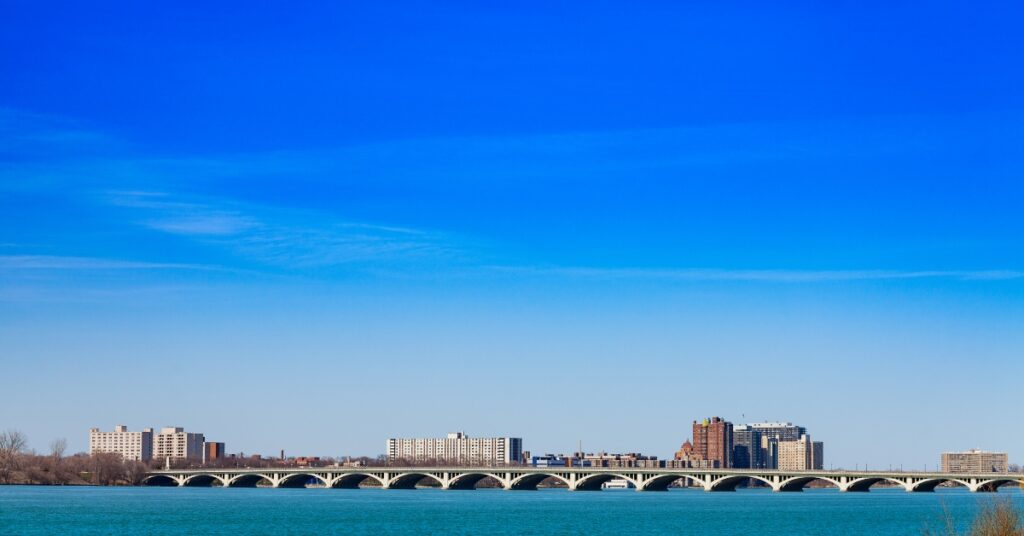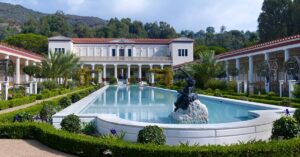Belle Isle Park is the largest island park in the United States. Located midway between Detroit, MI, and Windsor, Canada, the 987-acre island park features a 9-hole golf course, Dossin Great lakes maritime museum and a 150-acre state-protected wooded area. The Belle Isle Park offers beautiful unobstructed views of both the Detroit and Windsor skyline.
The Park’s History
To the original Chippewa and Ottawa Native Americans, the Park was known as Wah-na-be-zee, or Swan Island. The island was settled by French colonists in the 18th century, who named it Île aux Cochons (Hog Island). It was used by settlers to house pigs and chickens and protect them from coyotes on the mainland.
On May 4, 1768, Lieutenant George McDougall, a British soldier stationed in Detroit, was given permission by King George III to occupy Belle Isle. McDougall purchased the island on June 5, 1769, from the Ojibwa and Ottawa owners for a total of 8 barrels of rum, 3 rolls of tobacco, 6 pounds of vermillion, and a wampum belt.
Ownership of the island changed over the years, but Barnabus Campau eventually purchased it in 1817 for $5,000. In 1845, Campau renamed the island “Belle Isle.” It’s believed he named it in honor of Isabelle Cass, daughter of Michigan territorial governor and future U.S. Senator Lewis Cass. We’re fairly certain Isabelle’s girlfriends assured her it’s not the size of the island that counts, but being the largest anyhow, she was quite smitten.
Also Read
In 1879, the City of Detroit purchased the island from the descendants of Barnabus Campau for nearly $200,000 as part of a “Beautify Detroit” initiative. The name of the city’s newly acquired island was officially changed to “Belle Isle Park,” meaning “Beautiful Island” in French.
Frederick Law Olmstead, the same designer who designed New York City’s Central Park, designed the island into a park. Belle Isle would soon become Detroit’s first major city park and opened to the public in 1884.
Modern History
Completed in 1923, the European-esque Douglas MacArthur Bridge connects Belle Isle Park to the mainland. 30 years after its completion, in 1953, it was named so to honor General MacArthur, who rose to fame during World War II and the Korean War.

The Jewel of Belle Isle, the James Scott Memorial Fountain, is Situated on the Island’s western end. Completed in 1925, it is made of Vermont White Marble and boasts a central spray that rises 125 feet into the air. Architect Cass Gilbert designed the fountain as well as the William Livingstone Memorial Light (East side of Belle Isle), the only marble lighthouse in the United States.
1920-1940 marked the Golden Age of Belle Isle as the increase in automobiles made the Park more easily accessible. A highlight of Belle Isle is a beautiful botanical garden and the Anna Scripps Whitcomb Conservatory, the nation’s oldest conservatory. Both the casino and the conservatory were built by famed Detroit architect Albert Kahn.
Belle Isle Park Today
Situated just 10 miles north of Downtown Detroit the Park is a great escape from noisy city life. Recreational options include a nature center, wheelchair-accessible nature trail, playground, picnic shelters, tennis courts, basketball courts, baseball fields, and a golf course. It is also home to a wide variety of small animals, birds, and European fallow deer.
Many Detroiters volunteer their time and effort to preserve this island, particularly The Friends of Belle Isle. The non-profit group was formed in 1973 and is a grassroots organization dedicated to preserving and maintaining the unique island park. Park advocates argue that the 120-year-old island park could play a huge role in the city’s revival efforts and become a magnet for suburbanites and tourists alike. Together we can ensure Belle Isle Park becomes the splendid centerpiece of Detroit’s riverfront.






